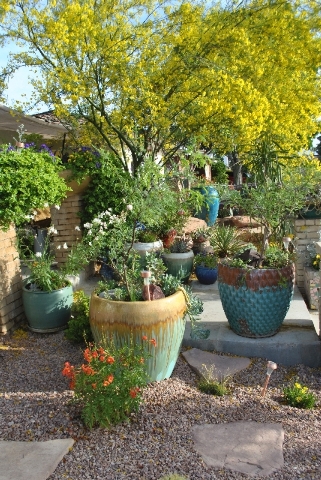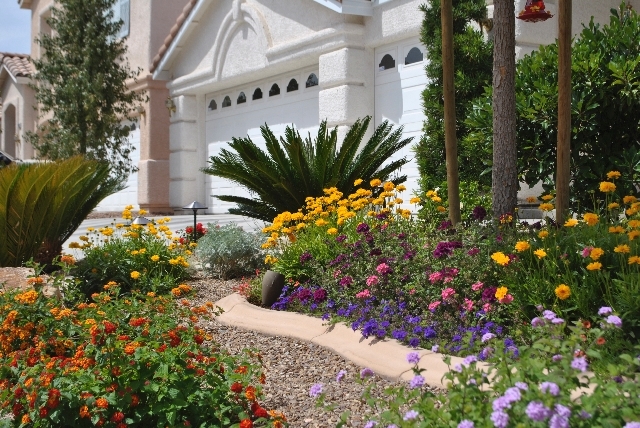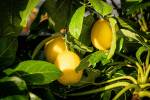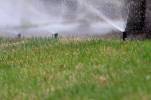Water conservation essential part of living in desert
We live in the desert.
With the temperatures we’ve experienced recently, this isn’t earth-shattering news.
But sometimes we forget, especially when it comes to something as precious as water and water conservation.
“For us, it is absolutely about having to do with limited availability,” said Doug Bennett, conservation manager for Southern Nevada Water Authority.
With the valley’s population expected to grow to about 2.4 million by 2030, according to state projections, it is imperative to make sure “everyone will have adequate water to meet his needs,” he said.
Bennett, who worked in Albuquerque, N.M., before coming to Las Vegas, said he once met a woman who complained about conserving water because “you are just going to give it to someone else.” And that’s exactly what Bennett wants to do.
He wants to use the resources he has before looking for new sources, especially if those resources are now being used wastefully.
In addition to conserving water for future residents, Bennett said it is more cost-effective to use existing water resources than to go out and purchase new water. That being said, even with greater conservation efforts, he said he doesn’t think current resources will be able to meet all of the valley’s future needs.
“It’s the right thing to do,” he said about area residents doing their part to conserve water.
He said most people would be surprised to learn that about 60 percent of all water used in the city is outdoors. In residential areas, that jumps to 70 percent for most of the year. In the hottest months , 90 percent of water is used outdoors and only 10 percent is for indoor activities such as showering, personal hygiene, laundry and washing dishes.
“One of our biggest challenges has always been that people have a misunderstanding of what they do to conserve water. If I asked a group if they conserved water, all would raise their hands. If I asked them what do they do, they would say they turn off the water when they are brushing their teeth. That should not be the No. 1 contribution to water efficiency in the desert. It’s not a big deal. We need people to realize that the bulk of their water use is happening outside their home.”
To help area residents conserve water more efficiently, Bennett offered seven tips, most of which cost little or nothing.
1. Check for leaks using water meter.
Bennett said it’s not the leaks you see, such as a dripping faucet, that waste the most water and cause the most damage. It is those that are hidden.
“Most of a home’s plumbing is not visible to you and it’s where the most damaging leaks are. Water can be seeping out under your home,” he said.
To check for hidden leaks, he said look at your water meter when no water is actively being used . If it shows water usage, there is a leak somewhere. There is a video on the water authority’s website that demonstrates how to read a water meter and has tips for dealing with a leak.
2. Properly schedule your watering system.
“One of the greatest wastes is to apply water when it is not yet needed. Learn how to apply water and when to apply it when it is needed again,” he said.
This can be done simply by checking the soil in your yard, and can “save literally tens of thousands of gallons over a year period.” Just as you would use your finger to check a houseplant’s soil before watering, poke the outdoor soil with a screwdriver, weeding tool or similar object. If the soil is moist, the tool will penetrate easily.
“Be sure to water only on your assigned day and only if the soil feels dryer than a wrung-out sponge,” Bennett said.
3. Adjust and repair your sprinkler system to achieve more even coverage.
Most sprinkler systems come on after dark or before sunrise and it is difficult to see coverage or broken sprinkler heads, he said. Every few weeks, a home’s sprinkler system should be manually turned on to make sure everything is working properly and sprinkler heads are pointed in the right direction.
“One single broken sprinkler head is the equivalent of a garden hose running. Then, your other sprinklers don’t work as well, you use more water and the entire system will suffer.”
Bennett said it is important to have sprinklers put water on an lawn as evenly as possible. Drip systems are not as finicky. You can add, remove or adjust the number of emitters based on how plants are performing.
“The biggest concern is the sprinkler system on a lawn. One single, full-circle sprinkler head uses more water than a typical shower head.”
4. Install a WaterSense certified smart controller.
According to Bennett, a smart controller uses weather data to determine how it should operate. It uses more water or waters more often in hot, dry weather, and less or no water if it is cooler or raining.
5. Replace nonfunctional turf with better adapted plantings.
This will result in more savings than anything else that can be done on a single piece of property, Bennett said. Lawns use four times as much water than other types of plantings.
He said to look for plants, shrubs, flowers and trees that can be drip irrigated and have a robust root system.
Bennett said he isn’t advocating eliminating lawns completely, just those that are purely ornamental. An easy way to determine that is if the only time the lawn in a specific area gets walked on is when you are pushing a lawn mower, then it’s time to replace it with something more water efficient.
“If all you want is green, you can do that with appropriately watered plants.”
6. Indoors, look for WaterSense labeled toilets, shower heads and faucets.
Bennett said one of the best things about these products — aside from the fact that they save water — is that they have all been laboratory tested for their functionality. A WaterSense toilet, for example, uses 20 percent less water and functions better.
7. Use your head — it is the most powerful water conservation tool.
Using a simple task that most of us have done, but don’t think about, Bennett said to consider how much water it takes to make orange juice from a can of concentrate. Each 12-ounce can make 64 ounces of juice, meaning the can needs to be refilled four times. “The vast majority of people won’t turn off the water when filling the cans. You can lose a full can of water between each pour. Typically, you use eight cans of water to get those four cans.
“You can do almost any task more water efficiently,” he said.
And Bennett knows it can be done. He saw it in the early stages of the drought. From 2002 to 2003, while the city was growing rapidly, residents cut Colorado River water usage by 50,000 acre-feet.
“We couldn’t attribute that to programs we designed. People were doing things on their own, that no one told them to do or gave them an incentive to do. We just have to be more conscientious ... Don’t take it for granted,” he said. “You still can get your orange juice, just use less water.”
Additional information and conservation tips can be found on the authority’s award-winning website, www.snwa.com. It also features rebates and coupons for smart irrigation controllers, rain sensors, pool covers and landscape conversions.





























